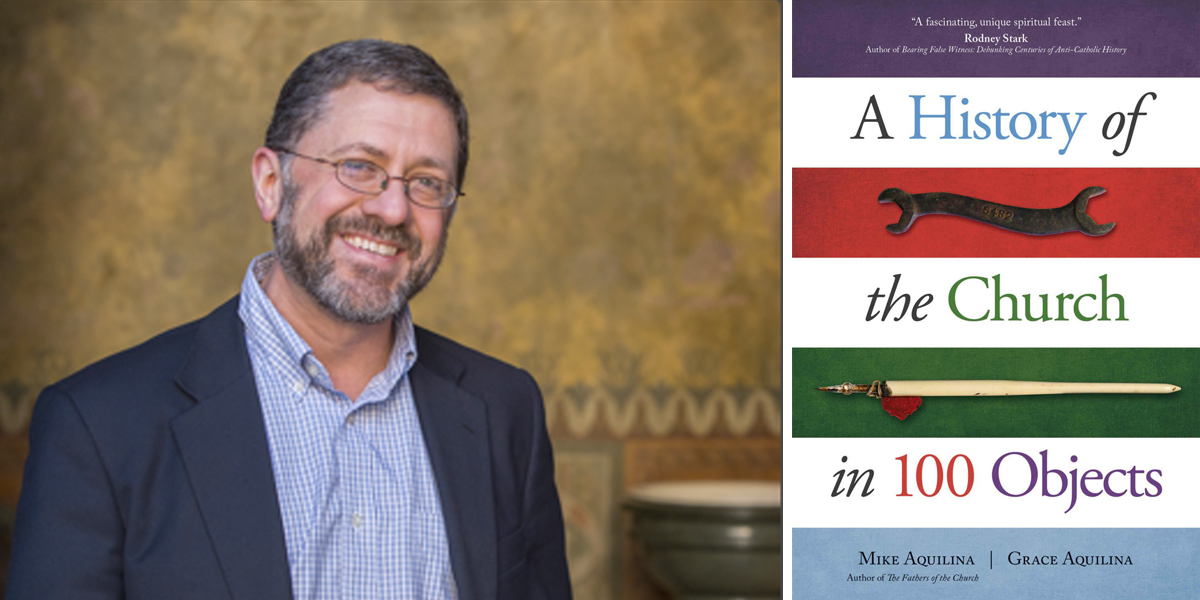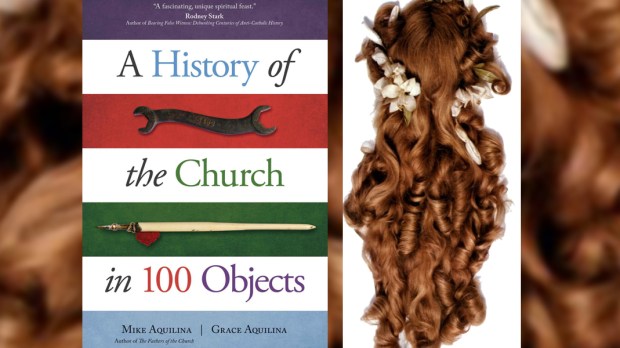Sometimes, the world can be such a tempting place, and in such surprising ways.
Take writers and books, for instance. When Neil MacGregor proposed to tell The History of the World in 100 Objects, another writer saw and realized that some of that history, and those objects, directly commingled the world with the Church that has been such an unstoppable force within the human story these 2,000 or so years.
The writer was Mike Aquilina, who — along with his daughter, Grace — realized there was a great deal to enlarge upon, in terms of the Church, and thus produced A History of the Church in 100 Objects. As the publisher, Ave Maria Press, puts it, “When Catholics tell their story, they don’t just write it in books. They preserve it in memorials, monuments, artifacts, and museums. They build grand basilicas to house tiny relics.”
Indeed, and this book’s fascinating look at everything from the Star of Bethlehem to wine vessels, to St. Patrick’s Bell, to the stylus of an anonymous scribe, to St. Francis’ tunic, and St. Therese of Lisieux’s chopped-off curls, and Cardinal Newman’s desk, really does give the reader a sense of the scope and universality of the Church throughout history. A History of the Church in 100 Objects is one of those books we love to keep on the table in the family room, where anyone can pick it up and enjoy it a few minutes, or hours, at a time.
Mike and Grace Aquilina answered a few fast questions for Aleteia.

What inspired the book?
Mike and Grace: Our love for history and our fascination with cool stuff—curios, artifacts, knickknacks, and tchotchkes. Most of the objects we’ve chosen to tell the stories are quite ordinary: a pen, a pill, a pair of shoes, a wrench, a pistol, a hole in the wall, a paving stone. But each played an important role in the drama of the Church’s history.
What person (or…object) in this book do you most personally identify with?
Mike: Barney the Dinosaur. If you don’t know why he’s in a book of Catholic history, then you need to read our book.
Grace: She’s only mentioned once, but I absolutely love Flannery O’Connor. I’m fascinated by how she uses dark humor and strange characters to communicate her deep love for the Church.
What story or anecdote (or piece of advice) in this book most personally resonated with you?
Mike: I like the chapter about St. Ignatius of Loyola’s bookshelves. It was books on those shelves that drew him to conversion and inspired him to live heroically. Since I write books for a living, the story gives me hope. Catholic books can make a big difference, in lives and in history.
Grace: I love the chapter about the spires of the Immaculate Conception Cathedral in South Korea. We use the image to talk about the Church’s growth in the global East. In preparing that chapter, I discovered how narrow my view of Christianity had been. The universality of the Catholic Church is a beautiful thing.
Did writing this book teach you anything?
Mike: Yes. It’s much cheaper to communicate with words than with visual images, especially if the images are of artifacts that belong to an archive or museum.
Grace: Every time I started research on one of our objects, I found so many new and fascinating topics and concepts to explore. It was difficult to not get carried away with research, and sometimes it was hard to keep the chapters from getting too long! You can’t learn just a little bit about the Catholic Church—it’s too rich and too interesting.
If there is one person you want to reach with this book, who would that be?
Mike and Grace: Someone who believes all the silly urban legends that pass for secular history about the Catholic Church.
What is the ideal beverage to have in hand while reading your book?
Mike: One of the objects we discuss is a Roman amphora that held several gallons of wine. An entire amphora is probably a bit much, but a glass of red might do the trick.

